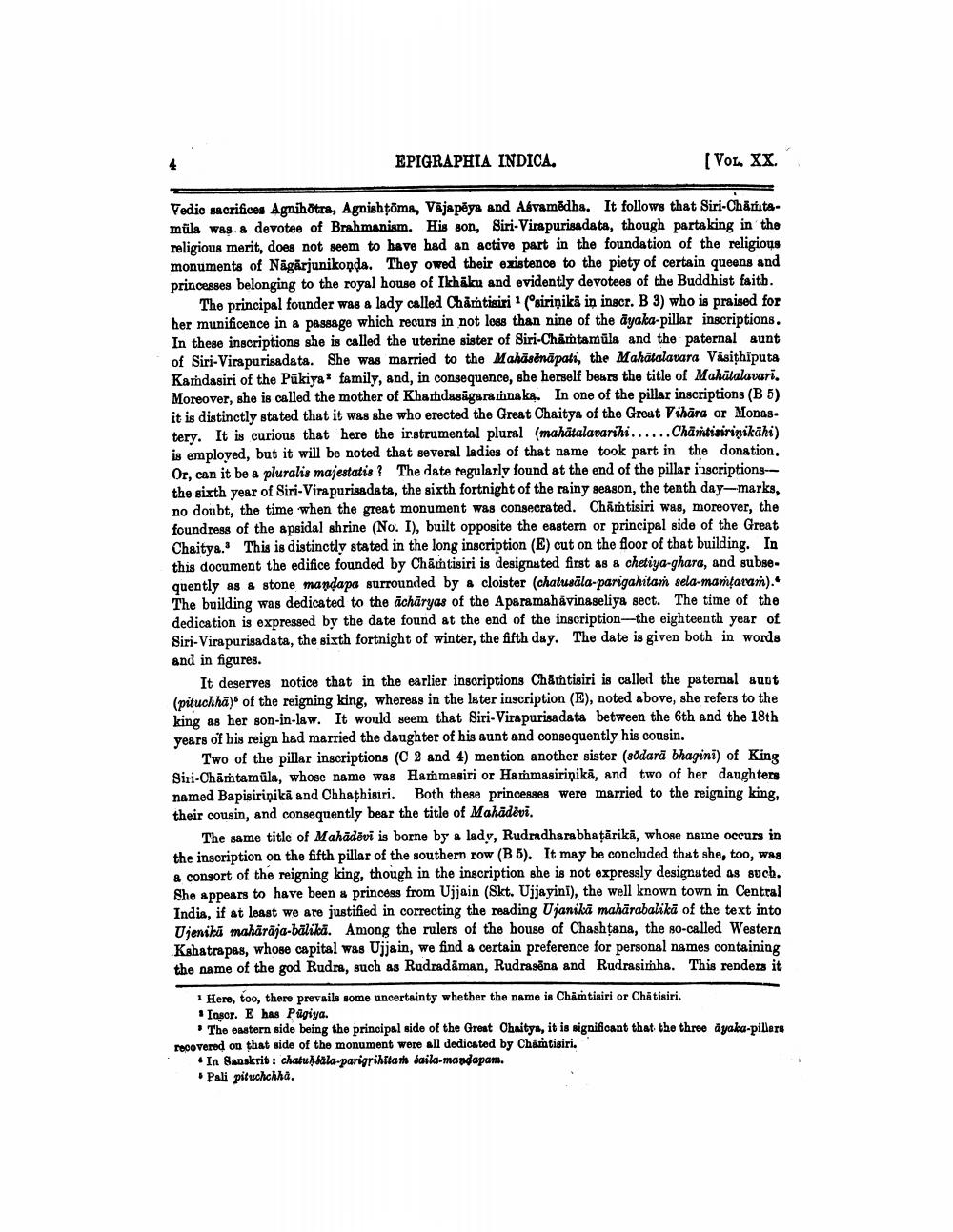________________
EPIGRAPHIA INDICA.
(Vol. XX.
Vedic sacrifices Agnihotra, Agnishtöma, Väjapěya and Abvamëdha. It follows that Siri-Chărutamtila was a devotee of Brahmanism. His son, Siri-Virapurisadata, though partaking in the religious merit, does not seem to have had an active part in the foundation of the religious monuments of Nagarjunikonda. They owed their existence to the piety of certain queens and princesses belonging to the royal house of Ikhāku and evidently devotees of the Buddhist faith.
The principal founder was a lady called Chåṁtisiri (sirinika in inscr. B 3) who is praised for her munificence in a passage which recurs in not loss than nine of the ayaka-pillar inscriptions. In these inscriptions she is called the uterine sister of Siri-Chämtamāla and the paternal aunt of Siri-Virspurisadata. She was married to the Mahäsénapati, the Mahātalavara Vasithiputa Kardasiri of the Pūkiya family, and, in consequence, she herself bears the title of Mahätalavari. Moreover, she is called the mother of Khamdasāgaramnaka. In one of the pillar inscriptions (B 5) it is distinctly stated that it was she who erected the Great Chaitya of the Great Vihara or Monas. tery. It is curious that here the irstrumental plural (mahätalavarihi......Charitisirinikāhi) is employed, but it will be noted that several ladies of that name took part in the donation, Or, can it be a pluralis majestatis ? The date regularly found at the end of the pillar inscriptions-- the sixth year of Siri-Vira purisadata, the sixth fortnight of the rainy season, the tenth day-marks, no doubt, the time when the great monument was consecrated. Chārtisiri was, moreover, the foundress of the apsidal shrine (No. I), built opposite the eastern or principal side of the Great Chaitya. This is distinctly stated in the long inscription (E) cut on the floor of that building. In this document the edifice founded by Chāṁtisiri is designated first as a chetiya-ghara, and subse. quently as a stone mandapa surrounded by a cloister (chatusäla-parigahitan sela-mamtaram). The building was dedicated to the acharyas of the Aparamahāvinaseliya sect. The time of the dedication is expressed by the date found at the end of the inscription--the eighteenth year of Siri-Virapurisadata, the sixth fortnight of winter, the fifth day. The date is given both in words and in figures.
It deserves notice that in the earlier inscriptions Chămtisiri is called the paternal aut (pituchha)" of the reigning king, whereas in the later inscription (E), noted above, she refers to the king as her son-in-law. It would seem that Siri-Virapurisadata between the 6th and the 18th years of his reign had married the daughter of his aunt and consequently his cousin.
Two of the pillar inscriptions (C 2 and 4) mention another sister (sðdarā bhagini) of King Siri-Chantamūla, whose name was Hammasiri or Hammasiriņikā, and two of her daughters named Bapisirinika and Chhathisiri. Both these princesses were married to the reigning king, their cousin, and consequently bear the title of Mahadevi.
The same title of Mahādevi is borne by a lady, Rudradharabhaţărika, whose name occurs in the inscription on the fifth pillar of the southern row (B 5). It may be concluded that she, too, was & consort of the reigning king, though in the inscription she is not expressly designated as such. She appears to have been a princess from Ujjain (Skt. Ujjayini), the well known town in Central India, if at least we are justified in correcting the reading Ujanikā mahärabalika of the text into Ujenika mahārāja-balika. Among the rulers of the house of Chashtana, the so-called Western Kshatrapas, whose capital was Ujjain, we find a certain preference for personal names containing the name of the god Rudra, such as Rudradāman, Rudrasēna and Rudrasimha. This renders it
1 Here, too, there provails some uncertainty whether the name is Chimtisiri or Chitisiri.
Insor. E has Palgiya.
• The eastern side being the principal side of the Great Chaitys, it is significant that the three ayaka-pillers recovered on that side of the monument were all dedicated by Chamisiri.
• In Sanskrit: chatula-parigrihftan baila-mandapam.
Pali pituchchha.




